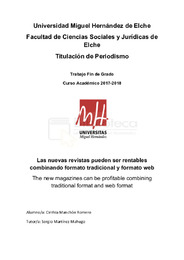Por favor, use este identificador para citar o enlazar este ítem:
https://hdl.handle.net/11000/7027Registro completo de metadatos
| Campo DC | Valor | Lengua/Idioma |
|---|---|---|
| dc.contributor.advisor | Martínez Mahugo, Sergio | - |
| dc.contributor.author | Manchón Romero, Cinthia | - |
| dc.contributor.other | Departamentos de la UMH::Ciencias Sociales y Humanas | es |
| dc.date.accessioned | 2021-01-26T16:17:14Z | - |
| dc.date.available | 2021-01-26T16:17:14Z | - |
| dc.date.created | 2018-06 | - |
| dc.date.issued | 2021-01-26 | - |
| dc.identifier.uri | http://hdl.handle.net/11000/7027 | - |
| dc.description.abstract | Las revistas Interviú y Tiempo anunciaron su cierre el pasado 8 de enero de 2018. En plena era digital el debate sobre la desaparición del papel es cada vez más repetitivo. La última encuesta de Pew Research Center muestra que el 65% de los jóvenes (entre 18 y 29 años) se informan por Internet y la caída de las inversiones en publicidad en los medios impresos no ayuda. Pero hay nuevas revistas que han sabido ver las ventajas de Internet y utilizarlas para alcanzar una moderada rentabilidad económica al combinar el formato tradicional con el formato web. Gracias a Internet, han creado fórmulas innovadoras para ahorrar costes de producción. Este reportaje analiza a través de entrevistas a distintos directores de revistas, a trabajadores de las mismas y a expertos en plataformas digitales y modelos de negocio cómo mediante suscripciones se realiza una tirada acorde a la demanda. Además, este trabajo quiere dar a conocer cómo con las diferentes plataformas y redes sociales se consigue atraer a nuevos lectores ofreciendo un contenido diferenciador y dinámico. | es |
| dc.description.abstract | The magazines Interview and Tiempo announced their company closure last 8th Janaury 2018. In the middle of digital era, the debate about the disappearance of paper in getting more and more repetitive. The last survey in Pew Research Center shows that 65% of the young (between 19 and 29 years old) are informed by Internet and the fall of the investments in publicity in the printed means doesn’t help. But there are new magazines which have known to capture the advantages of Internet and use them to reach a moderate economic profitability, sharing the tradicional format with the web format. Thanks to Internet, innovative formulas have been created to save the production cost. This report analyses through interviews to different magazine directors, employces in the same magazines, experts in digital plataforms and business models how through subscriptions, an edition in done according to the demand. Furthermore, this work wants to make known how with the different platforms ans social nets get to attract new readers offering a diferentiating, dynamic content. | es |
| dc.format | application/pdf | es |
| dc.format.extent | 34 | es |
| dc.language.iso | spa | es |
| dc.rights | info:eu-repo/semantics/openAccess | es |
| dc.subject | revistas digitales | es |
| dc.subject | digital magazines | es |
| dc.subject | revistas tradicionales | es |
| dc.subject | rentabilidad | es |
| dc.subject | web | es |
| dc.subject | papel | es |
| dc.subject | traditional magazines | es |
| dc.subject | profitability | es |
| dc.subject | paper | es |
| dc.subject.other | CDU::0 - Generalidades.::070 - Periódicos. Prensa. Periodismo. Ciencias de la información | es |
| dc.title | Las nuevas revistas pueden ser rentables combinando formato tradicional y formato web | es |
| dc.title.alternative | The new magazines can be profitable combining traditional format and web format | es |
| dc.type | info:eu-repo/semantics/bachelorThesis | es |

Ver/Abrir:
PER_TFG_MANCHÓN_ROMERO_CINTHIA.pdf
4,51 MB
Adobe PDF
Compartir:
 La licencia se describe como: Atribución-NonComercial-NoDerivada 4.0 Internacional.
La licencia se describe como: Atribución-NonComercial-NoDerivada 4.0 Internacional.
.png)